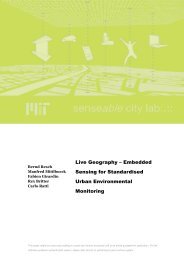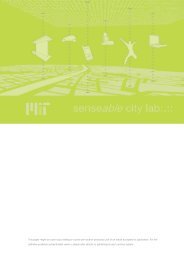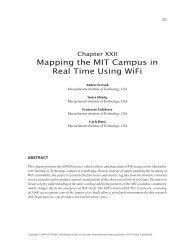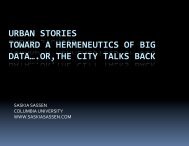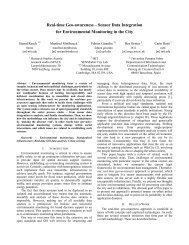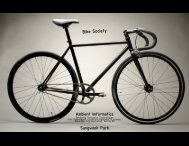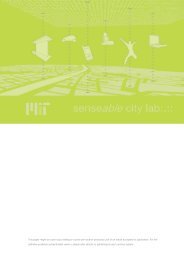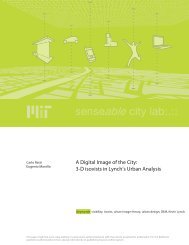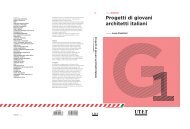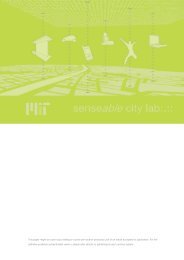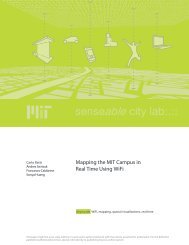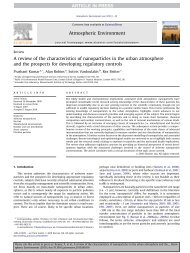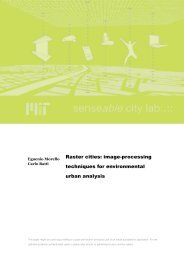author's proof
author's proof
author's proof
You also want an ePaper? Increase the reach of your titles
YUMPU automatically turns print PDFs into web optimized ePapers that Google loves.
AUTHOR'S PROOFJrnlID 10666_ArtID 9236_Proof# 1 - 21/08/2010S. Vardoulakis et al.608 9. Lin, Z., Jiang, F., Chow, T. T., Tsang, C. F., & Lu, W. Z.609 (2006). CFD analysis of ventilation effectiveness in a public610 transport interchange. Building and Environment, 41(3), 254–611 261.612 10. Chow, W. K. (1996). Application of computational fluid dynamics613 in building services engineering. Building and Environment, 31614 (5), 425–436.615 11. Stamou, A., & Katsiris, I. (2006). Verification of a CFD model for616 indoor airflow and heat transfer. Building and Environment, 41(9),617 1171–1181.618 12. Stathopoulou, O. I., & Assimakopoulos, V. D. (2008). Numerical619 study of the indoor environmental conditions of a large athletic620 hall using the CFD code PHOENICS. Environmental Modeling621 and Assessment, 13(3), 449–458.622 13. Gao, N., & Niu, J. (2004). CFD study on micro-environment623 around human body and personalized ventilation. Building and624 Environment, 39(7), 795–805.625 14. Gosman, A. D. (1999). Developments in CFD for industrial and626 environmental applications in wind engineering. Journal of Wind627 Engineering and Industrial Aerodynamics, 81, 21–39.628 15. Kim, S. E., & Boysan, F. (1999). Application of CFD to629 environmental flows. Journal of Wind Engineering and Industrial630 Aerodynamics, 81, 145–158.631 16. Grawe, D., Cai, X. M., & Harrison, R. M. (2007). Large eddy632 simulation of shading effects on NO 2 and O 3 concentrations633 within an idealised street canyon. Atmospheric Environment, 41634 (34), 7304–7314.635 17. Cai, X. M., Barlow, J. F., & Belcher, S. E. (2008). Dispersion636 and transfer of passive scalars in and above street canyons—637 Large-eddy simulations. Atmospheric Environment, 42(23),638 5885–5895.639 18. Smith, W. S., Reisner, J. M., & Kao, C. Y. J. (2001). Simulations640 of flow around a cubical building: comparison with towing-tank641 data and assessment of radiatively induced thermal effects.642 Atmospheric Environment, 35(22), 3811–3821.643 19. Sahm, P., Louka, P., Ketzel, M., Guilloteau, E., & Sini, J.-F.644 (2002). Intercomparison of numerical urban dispersion models—645 Part I: Street canyon and single building configurations. Water,646 Air, & Soil Pollution: Focus, 2, 587–601.647 20. Richards, P. J., & Quinn, A. D. (2002). A 6 m cube in an648 atmospheric boundary layer flow Part 2. Computational solutions.649 Wind and Structures, 5(2–4), 177–192.650 21. Lakehal, D., & Rodi, W. (1997). Calculation of the flow past a651 surface-mounted cube with two-layer turbulence models. Journal652 of Wind Engineering and Industrial Aerodynamics, 67–8, 65–78.653 22. Murakami, S. (1998). Overview of turbulence models applied in654 CWE-1997. Journal of Wind Engineering and Industrial Aerody-655 namics, 74–6, 1–24.656 23. Meroney, R. N., Leitl, B. M., Rafailidis, S., & Schatzmann, M.657 (1999). Wind-tunnel and numerical modeling of flow and658 dispersion about several building shapes. Journal of Wind659 Engineering and Industrial Aerodynamics, 81, 333–345.660 24. Ketzel, M., Louka, P., Sahm, P., Guilloteau, E., Sini, J.-F., &661 Moussiopoulos, N. (2002). Intercomparison of numerical urban662 dispersion models—Part II: Street canyon in Hannover, Germany.663 Water, Air, & Soil Pollution: Focus, 2, 603–613.664 25. Vardoulakis, S., Fisher, B. E. A., Pericleous, K., & Gonzalez-665 Flesca, N. (2003). Modelling air quality in street canyons: a666 review. Atmospheric Environment, 37(2), 155–182.667 26. Sini, J.-F., Anquetin, S., & Mestayer, P. G. (1996). Pollutant668 dispersion and thermal effects in urban street canyons. Atmo-669 spheric Environment, 30(15), 2659–2677.670 27. Louka, P., Vachon, G., Sini, J.-F., Mestayer, P. G., & Rosant, J.-M.671 (2002). Thermal effects on the airflow in a street canyon—Nantes672 ‘99 experimental results and model simulations. Water, Air, & Soil673 Pollution: Focus, 2, 351–364.28. Schatzmann, M., & Leitl, B. (2009). Evaluation of numerical flowand dispersion models for applications in industrial and urbanareas. Chemical Engineering and Technology, 32, 241–246.29. Sagrado, A. P. G., van Beeck, J., Rambaud, P., & Olivari, D.(2002). Numerical and experimental modelling of pollutantdispersion in a street canyon. Journal of Wind Engineering andIndustrial Aerodynamics, 90(4–5), 321–339.30. Wright, N. G., & Easom, G. J. (2003). Non-linear k-epsilonturbulence model results for flow over a building at full-scale.Applied Mathematical Modelling, 27(12), 1013–1033.31. Richards, P. J., Hoxey, R. P., & Short, L. J. (2001). Wind pressureson a 6 m cube. Journal of Wind Engineering and IndustrialAerodynamics, 89(14–15), 1553–1564.32. Hoxey, R. P., Richards, P. J., & Short, J. L. (2002). A 6 m cube inan atmospheric boundary layer flow Part 1. Full-scale and windtunnelresults. Wind and Structures, 5(2–4), 165–176.33. Papadopoulos, A. M., & Moussiopoulos, N. (2004). Towards aholistic approach for the urban environment and its impact onenergy utilisation in buildings: The ATREUS project. Journal ofEnvironmental Monitoring, 6(10), 841–848.34. Schatzmann, M., Donat, J., Hendel, S., & Krishan, G. (1995).Design of a low-cost stratified boundary-layer wind tunnel.Journal of Wind Engineering and Industrial Aerodynamics, 54–55, 483–491.35. Richards, K., Schatzmann, M., & Leitl, B. (2006). Wind tunnelexperiments modelling the thermal effects within the vicinity of asingle block building with leeward wall heating. Journal of WindEngineering and Industrial Aerodynamics, 94(8), 621–636.36. MIHU (2010). Environmental Wind Tunnel Laboratory FacilitiesMeteorological Institute. Hamburg University, http://www.mi.unihamburg.de/Facilities.311.0.html.Accessed 28 May 2010.37. Ehrhard, J., Khatib, I. A., Winkler, C., Kunz, R., Moussiopoulos,N., & Ernst, G. (2000). The microscale model MIMO: Developmentand assessment. Journal of Wind Engineering and IndustrialAerodynamics, 85(2), 163–176.38. Assimakopoulos, V. D., ApSimon, H. M., & Moussiopoulos, N.(2003). A numerical study of atmospheric pollutant dispersion indifferent two-dimensional street canyon configurations. AtmosphericEnvironment, 37(29), 4037–4049.39. Moussiopoulos, N., Barmpas, P., Ossanlis, I., & Bartzis, J. (2008).Comparison of numerical and experimental results for theevaluation of the depollution effectiveness of photocatalyticcoverings in street canyons. Environmental Modeling and Assessment,13(3), 357–368.40. Borrego, C., Tchepel, O., Costa, A. M., Amorim, J. H., &Miranda, A. I. (2003). Emission and dispersion modelling ofLisbon air quality at local scale. Atmospheric Environment, 37(37), 5197–5205.41. Chan, T. L., Dong, G., Leung, C. W., Cheung, C. S., & Hung, W.T. (2002). Validation of a two-dimensional pollutant dispersionmodel in an isolated street canyon. Atmospheric Environment, 36(5), 861–872.42. Hamlyn, D., & Britter, R. (2005). A numerical study of the flowfield and exchange processes within a canopy of urban-typeroughness. Atmospheric Environment, 39(18), 3243–3254.43. Di Sabatino, S., Buccolieri, R., Pulvirenti, B., & Britter, R. E.(2008). Flow and pollutant dispersion in street canyons usingFLUENT and ADMS-Urban. Environmental Modeling andAssessment, 13(3), 369–381.44. EIONET (2010). Model documentation system. European TopicCentre on Air and Climate Change. European EnvironmentInformation and Observation Network. http://air-climate.eionet.europa.eu/databases/MDS/. Accessed 28 May 2010.45. Jones, W. P., & Launder, B. E. (1972). Prediction of laminarizationwith a 2-equation model of turbulence. International Journalof Heat and Mass Transfer, 15(2), 301–314.UNCORRECTED PROOF674675676677678679680681682683684685686687688689690691692693694695696697698699700701702703704705706707708709710711712713714715716717718719720721722723724725726727728729730731732733734735736737738739



